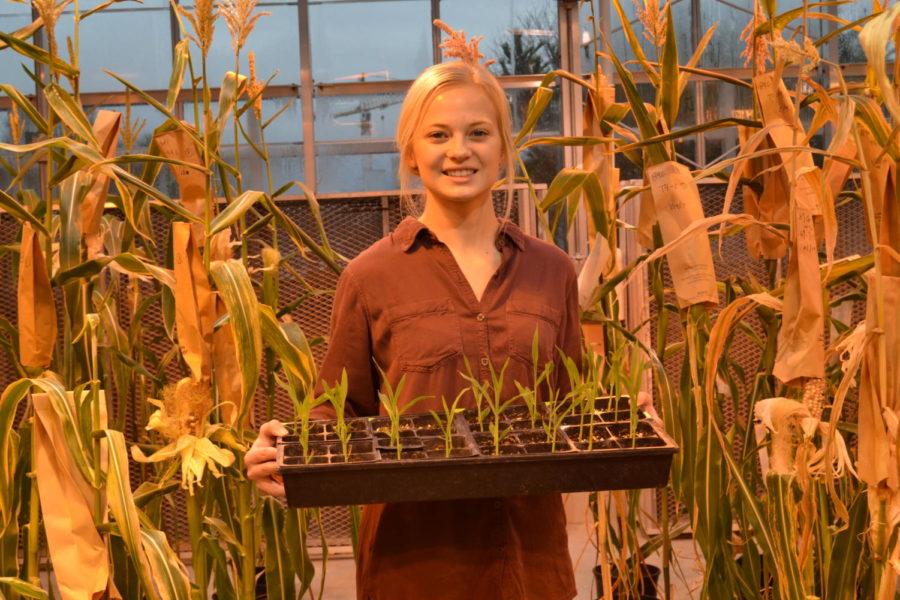ISU senior conducts study relating to transposable elements
Raegen Hoefler, junior in genetics, holds some of her plants she has been growing for her research project, “Maize on Mars.” Hoefler has been researching since August, and she conducts her research in a greenhouse inside of the Molecular Biology Building.
February 28, 2017
In the 2015 film, “The Martian,” astronaut Mark Watney survives after being stranded on Mars by cultivating potatoes.
Raegan Hoefler, Iowa State senior in genetics, is conducting a study alongside Thomas Peterson, biology 212 professor, to see if this is plausible by looking at transposable elements. Peterson is a professor and pioneer chair in maize molecular genetics.
The name of her project is “Growing Maize on Mars: Effects of Irradiation Induced Transposable Element Activity on Plant Survival and Development.” It was awarded to her with a $7,000 scholarship from the Iowa Space Grant Consortium.
Working in maize genetics, Peterson never saw the connection between genetics and a space grant.
“She came up with this possibility of how can we test whether it would really be possible to grow a crop plant, that’s used to an earth environment, in a space environment,” Peterson said.
“’The Martian’ had just come out and was something we and the public could relate to,” Hoefler said.
Transposable elements (transposons) are sequences of DNA that can move around within the genome. Most of these transposons are considered silent, meaning they’re not expressed or active.
The research is based on the findings of Barbara McClintock, a maize geneticist in the 1940s who studied corn that had been irradiated to produce broken chromosomes.
Through her studies, she put forth a theory: these transposons are resident in our genomes. Most may be silent, but in times of stress or new environmental conditions, they may become active and cause rearrangements in the genome that may be adaptive and provide benefit.
“We know that in space and on Mars, plants will be exposed to radiation because they don’t have the atmosphere to protect,” Peterson said. “What would that do to the transposable elements to that genome?
“If we try to grow plants in space, will the transposons become active, and if they do, will it be helpful or destructive? If they all became active at the same time, the chromosome would just shatter,” Peterson said.
At a greenhouse in the Molecular Biology Building, Hoefler exposes maize crops to different levels of ultraviolet and X-ray radiation. She will then measure the height of each individual plant she’s testing.
In the next couple of weeks, Hoefler will send her plant DNA to BGI America to get sequenced. This will allow her to see if transposable elements have moved. She hopes to finish the study next fall.
“Growing up on a farm, I always knew I wanted to do something with agriculture,” Hoefler said. “I’ve always been interested in what mechanisms crops and plants use to tolerate stresses.”
Hoefler believes this is important as the possibility of living on Mars, and the earth becoming more Martian-like, grows.
“Hopefully I can contribute to how the public perceives science and how they perceive their food,” Hoefler said.







